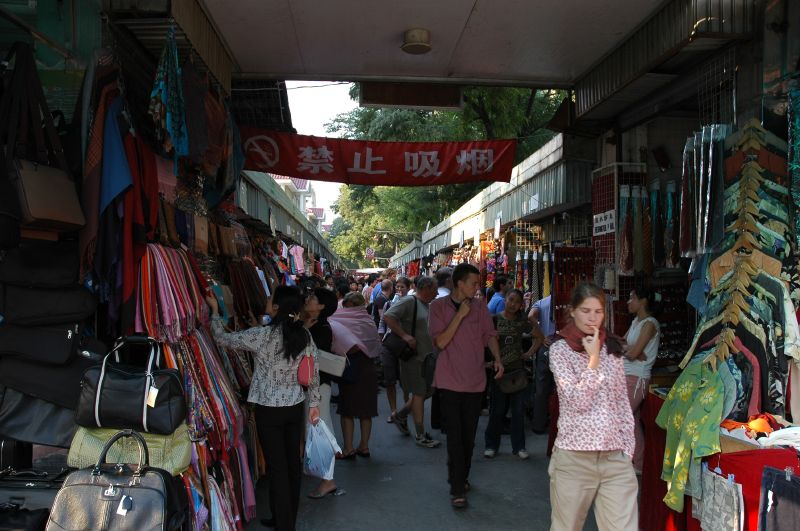The Art of the Chinese Sale, also known as The Calculator Game, is actually a lot of fun! I never considered myself much of a bargainer or a haggler – it felt way too pushy – so what happened was a bit surprising.
Everyday in Beijing, I went somewhere on my own, but the Xiu Shui Silk Market was my favourite place to shop, and there were hundreds of tiny stalls lined up along alleyways with clothes and other goods hanging 8 feet high on the walls, lining the floors, and piled high on tables. Five levels filled to the brim with tightly filled aisles of shops, it was chockfull of anything you can imagine – not just things made with silk.

It was hard to take it all in when in every direction there seemed to be something you wanted to look closer at, and distractions were everywhere. It would take a week to see it all!
Not only do they have the best selection of anything you might be looking for, but there were no price tags, so you bargained for everything. That could be a negative thing if you’re not ready to bargain, and to bargain very AGGRESSIVELY!
These people mean business and so should you. Most of the people you bargain with are young women of small delicate stature but in seconds, they can become sharply intimidating, with eyes of steel, and a demeanor that would make a lion cry!
If you’re browsing, they will eat you alive: they want you to be buying, not browsing. That is, if you so much as hesitate, as you walk by their stall, or look up at anything or down at anything, they will be on you like glue.
L advised me to go in there with a plan and stick with it; be as firm with them as they will be with you.
I clutched my purse, and marched in to the Silk Market.
Since I only knew one amount in the Chinese Yuan and that amount was equal to $20 CAD, that was the amount I always offered. Everything that I wanted to buy I would write 118 Yuan on the big calculator that every stall owner carried.
The owner would then smile broadly, and say something like, “No No”, and write back on the calculator, 200 Yuan, passing the calculator back to me.
I would repeat my 118 Yuan.
Smiling sweetly, they would look at me and say, “Ok, my friend, for you I give for 180 Yuan,” and pass the calculator back to me.
I would repeat again 118 Yuan.
They would look a bit confused and raise an eyebrow, smiling a little less now, writing 160 Yuan.
Again I would write back 118 Yuan.
Then the sweet smiles would turn sour, and they would start getting agitated, saying, “No, No, I make No Money!“
I would say nothing.
Then they would shove the calculator at me almost angrily with 140 Yuan, and a pinched mouth.
Again I would write back 118 Yuan.
This time the stall owner would start cursing in Chinese and turn abruptly away saying “No, No. I lose money Lady – NO!”
I would shrug innocently, and walk calmly walk away.
Before I got ten steps away, I invariably heard, “Lady, Lady – OK, OKAY!“
And I would buy the item for 118 yen or $20. I bought cashmere sweaters, coats, pearls, shoes, suitcases, and many other items for $20. Smaller items were often purchased at 4 for $20! Of course everything is cash only at the silk market.
You can bargain all day for everything from tailored suits to kites to Chinese stamps to knock-off shoes, watches, and purses to brand name jeans, jewellery, pearls, glasses.
What a great time it was, and everything I bought was at a fraction of what it normally would of cost. It was a frenzied experience shopping at the Silk Market, but absolutely exhilarating!
When I returned to the apartment, my friend L was shocked at my bargaining skills. “You are better than most Chinese people!” she exclaimed.
L also took me shopping in a Chinese department store one day. The prices were reasonable and there was no bargaining, but the clothes I bought there and at the Silk Market were far ahead of the styles back home. I continue to wear and receive compliments on those coats, blazers, silk dresses, and so on for many years after I have returned home. They all seemed to be unique while retaining a classic elegance. Although to be in the silk market is not exactly an elegant experience, it certainly is unique and stimulating!


Then there were the sweet sales girls…

Turning not-so-sweet…


The Silk Market…

Loved this sign at the Silk Market…








Pingback: Full Moon Over Beijing | TRAVEL TO LITTLE KNOWN PLACES
That’s a cute sign of recommended words lol. Did you or the sales people use them or what is it for?
It’s a sign on the wall in the Silk Market where they sell all kinds of goods. I guess it’s for the sales people, but also used as humour for all. There is a lot of use of the forbidden words, so I guess it reminds salespeople and buyers to be nice by teasing them a little!